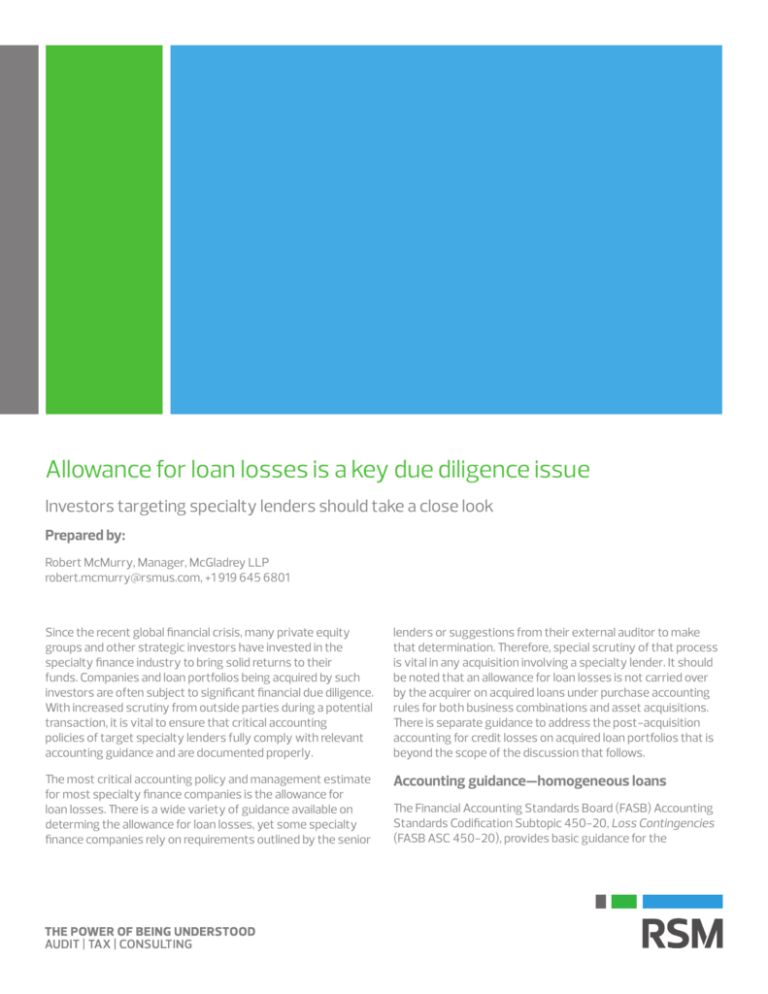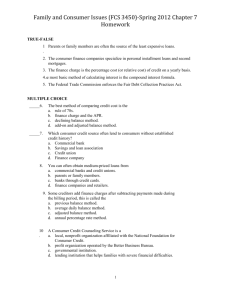
Allowance for loan losses is a key due diligence issue
Investors targeting specialty lenders should take a close look
Prepared by:
Robert McMurry, Manager, McGladrey LLP
robert.mcmurry@rsmus.com, +1 919 645 6801
Since the recent global financial crisis, many private equity
groups and other strategic investors have invested in the
specialty finance industry to bring solid returns to their
funds. Companies and loan portfolios being acquired by such
investors are often subject to significant financial due diligence.
With increased scrutiny from outside parties during a potential
transaction, it is vital to ensure that critical accounting
policies of target specialty lenders fully comply with relevant
accounting guidance and are documented properly.
lenders or suggestions from their external auditor to make
that determination. Therefore, special scrutiny of that process
is vital in any acquisition involving a specialty lender. It should
be noted that an allowance for loan losses is not carried over
by the acquirer on acquired loans under purchase accounting
rules for both business combinations and asset acquisitions.
There is separate guidance to address the post-acquisition
accounting for credit losses on acquired loan portfolios that is
beyond the scope of the discussion that follows.
The most critical accounting policy and management estimate
for most specialty finance companies is the allowance for
loan losses. There is a wide variety of guidance available on
determing the allowance for loan losses, yet some specialty
finance companies rely on requirements outlined by the senior
Accounting guidance—homogeneous loans
The Financial Accounting Standards Board (FASB) Accounting
Standards Codification Subtopic 450-20, Loss Contingencies
(FASB ASC 450-20), provides basic guidance for the
recognition of losses for homogeneous loans. This covers most
of the loans that specialty finance companies originate and
service. Homogeneous loans are groups of smaller balance
loans with the same or similar characteristics. For example,
a company that offers direct consumer loans and indirect
auto loans would likely have two distinct homogeneous loan
pools. For homogeneous loans, FASB ASC 450-20 requires
the allowance to be recognized when loan losses are both
probable at the financial statement date or the date the
financial statements are available to be issued, and the losses
are reasonably estimable (an incurred loss model).
For specialty finance companies serving near-prime or
subprime borrowers, a loan loss typically becomes likely, or
probable, when a customer loses their job or experiences
some other type of financial hardship. With homogeneous
pools of hundreds or thousands of individual loans, it is not
practical to evaluate each borrower’s financial situation on a
loan-by-loan basis. As a result, management must estimate
the amount of probable losses based on historical loss trends
and other relevant factors.
Estimation process
In 2006, the federal agencies that regulate banks and credit
unions collaborated to issue an Interagency Policy Statement
on the Allowance for Loan and Lease Losses (Interagency
Policy Statement). The Interagency Policy Statement
indicates that management should consider “all significant
factors that affect the collectability of the portfolio as of
the evaluation date.” The Interagency Policy Statement also
states that the estimate should be properly supported and
documented by the company. While the applicability of this
guidance is limited to depository institutions supervised
by these agencies, it reiterates key concepts of generally
accepted accounting principles (GAAP) and serves as useful
guidance in applying GAAP.
For SEC registrants, the Securities and Exchange Commission
provides additional guidance with respect to the accounting
for loan losses, including reemphasizing that a lender should
“develop and document a systematic methodology to
determine its provision for loan losses and allowance for loan
losses.” This guidance is included in the FASB codification at
ASC 310-10-S99, and also makes reference to the AICPA Audit
and Accounting Guide for Depository and Lending Institutions
for additional guidance.
One key item in developing the allowance for loan losses is the
determination of the appropriate historical loss period. The
Interagency Policy Statement states that lenders generally
“should use at least an annualized or 12-month average net
charge-off rate that will be applied” to the homogeneous
groups of loans being evaluated. This is also a common
minimum allowance calculation required by lenders to the
specialty finance industry. However, the Interagency Policy
Statement also indicates that loans with effective lives shorter
than 12 months “may indicate that the estimated credit losses
should be less than” a trailing 12-month loss rate. As a result,
the determination and documentation of the effective life of
each homogeneous pool is a critical exercise.
While historical loss rates generally serve as the starting
point for estimating the allowance on homogeneous loans,
management should also consider qualitative factors that
are likely to cause credit losses to differ from historical levels.
Although not an all-encompassing list, the Interagency Policy
Statement provides a list of qualitative factors to consider in
estimating the allowance, including:
• Changes in lending policies and procedures, such as
underwriting standards, collection, charge-off and
recovery practices
• Changes in relevant economic and business conditions
(international, national, regional and local)
• Changes in the nature and volume of the portfolio and the
term of loans offered
• Changes in the company’s delinquent and nonaccrual loans
• Changes in the value of collateral for secured loans (such as
auto loans)
• Any concentrations of credit
• Other external factors, which may include competition, or
legal and regulatory developments
Another potential factor specific to specialty finance
companies could be trends in the use of loan modifications
or refinancing. It is relatively common for specialty finance
companies to provide modifications, such as payment
deferments, to customers. If, however, the number of such
modifications is trending upward, this could, in effect, decrease
the delinquency rate. This qualitative change should be taken
into consideration. Additionally, if there has been significant
growth in the loan portfolio, the recent historical loss rate
may be low, since losses on the more recent originations
would not have occurred yet. Newly created specialty finance
companies or companies without sufficient historical loss
rates should use benchmark information or loss rates of other
companies with similar types of loans to help establish initial
allowance calculations until the company has sufficient loss
rate information.
The changes in the allowance should be consistent with
the changes in the factors that are considered significant in
evaluating the collectability of the portfolio when taken as
a whole. For example, if underwriting standards have been
loosened, the relevant economic conditions are deteriorating
and the level of delinquent loans is increasing, it would likely
not make sense for the allowance for loan losses to decrease.
The process for determining the allowance for loan losses
should be consistent, yet flexible, to consider new trends that
may impact the collectability of the portfolio.
In terms of consistency, for example, consider a specialty
finance company that has historically used a trailing 12-month
loss rate for the starting point of its allowance calculation. It
would not make sense in a subsequent period to change to
a shorter period loss rate without supporting analysis that
provides justification for the change.
2
To understand the need for flexibility, consider how specialty
finance companies had to react to events as loan losses
increased during the financial crisis in late 2008 and early
2009. Certain key changes, such as sudden spikes in gasoline
prices or unemployment, may not have been anticipated as
relevant factors before the crisis. Clearly, such events need to
be considered going forward for companies who hold portfolios
that would be impacted by these events.
rates of 30 percent or greater for accounts with confirmed
Chapter 13 bankruptcy plans. FASB ASC 310-10-35-21 allows
the impairment for groups of individually impaired loans with
similar risk characteristics (such as accounts in Chapter 13
bankruptcy) to be measured in aggregate using average
historical statistics.
The questions and answers to the Interagency Policy
Statement also indicate that when loans included in
homogeneous pools are modified in a troubled debt
restructuring (TDR), such loans should be removed from the
homogeneous pools and individually evaluated for impairment,
which is the emphasis of the section that follows.
Final guidance is expected to be issued by the FASB in
late 2015 or early 2016 that will change the accounting
requirements that specialty lenders follow in determining
their allowance for loan losses. Under the proposed new
guidance, specialty lenders will need to recognize an allowance
for expected loan losses throughout the life of the loan on
the day a loan is originated (referred to as CECL), instead of
following an incurred loss model. The federal agencies that
issued the Interagency Policy Statement referenced above
plan to collaborate to issue revised guidance after the CECL
accounting guidance is issued by FASB.
Accounting guidance—loans individually evaluated
FASB ASC Subsection 310-10-35 and related implementation
guidance at ASC 310-10-55 provides guidance for accounting
for an allowance for loan losses for specific loans that are
evaluated individually for impairment. This generally excludes
large groups of smaller balance homogeneous loans, which
are collectively evaluated for impairment as discussed above.
However, as is also noted above, loans within a homogeneous
pool that are determined to be TDRs should be evaluated
individually for impairment. Since most specialty finance
companies hold only smaller-balance homogeneous loans,
loans evaluated individually may be limited to TDRs. A TDR is
a loan for which a creditor grants a concession to a borrower
who is experiencing financial difficulties, for economic or legal
reasons that it would not otherwise consider. A common
TDR for most specialty finance companies is a customer who
files for Chapter 13 bankruptcy and has a court-approved
plan that reduces the interest rate, lengthens the term of the
loan or reduces the principal amount of the loan. If a specialty
finance company provides any concessions to borrowers,
generally in order to recover as much principal as possible, such
concessions should be evaluated under FASB ASC 310-40 to
determine if they are TDRs.
Once TDRs and other individually evaluated impaired loans
have been identified, the impairment and resulting allowance
is generally calculated by estimating the cash flows that will be
collected from the modified loan agreement, and computing
the present value using the original contractual interest
rate and comparing this present value to the loan’s carrying
amount.1 For example, if a $1,000 loan that bore interest at
10 percent and had a remaining term of 12 months was
modified to reduce the interest rate to 5 percent and extend
the term to 24 months, the impairment would be $49,
regardless of whether management expected to collect the
full $1,000. For companies charging higher interest rates, the
impact of TDRs can be much more dramatic, with impairment
1
ASC 310-10-35-22, as a practical expedient, permits the use of
observable market prices or the fair value of collateral (for collateral
dependent loans) to be used to measure impairment. Generally,
collateral-dependent loans would be real estate loans. For loans for
which foreclosure is probable, ASC 310-10-35-32 requires impairment to
be measured based on the fair value of the collateral.
Forthcoming changes to accounting guidance
Although the CECL requirements are not expected to apply
until at least 2018, specialty lenders should begin evaluating
their processes and tools to determine if they are capturing
all of the information that will be necessary to prepare
forecasts of future loan losses that will be required by the
CECL guidance.
Visit the FASB website for further detail on CECL.
Summary
Specialty finance companies should employ a systematic
approach to determine the allowance for loan losses as follows:
• Disaggregate the loan portfolio into appropriate
homogeneous pools
• Calculate and document the rationale to support the
appropriate historical loss rate and period for each
homogeneous pool
• Evaluate all relevant qualitative factors that may impact the
collectability of the portfolio
• Determine whether any TDRs exist and calculate any
necessary impairment specific to TDRs
• Take an overall look at the allowance and verify its
movement is directionally consistent with all factors taken
as a whole
Potential investors in specialty finance companies should
carefully consider if the allowance for loan losses is properly
determined by the specialty finance company, in accordance
with GAAP, which will provide more meaningful comparisons
to other companies in the industry during the due diligence
and evaluation phases. Additionally, maintaining and
documenting a consistent approach will prove to be valuable
to specialty finance companies that are seeking to be acquired
when external parties come in to evaluate the allowance
for loan losses. Potential investors should also consider the
current capabilities that specialty finance companies have to
capture and analyze all of the data that will be necessary to
prepare forecasts of future loan losses that will be required by
the forthcoming CECL accounting guidance.
3
+1 800 274 3978
www.rsmus.com
As of the date of this publication, RSM US LLP, an Iowa limited liability partnership, is doing business as
McGladrey LLP in the state of North Carolina and is a CPA firm registered with the North Carolina State
Board of Certified Public Accountants under the name McGladrey LLP. Rules permitting the use of RSM
US LLP have been published in the North Carolina Register and are pending final approval.
This publication represents the views of the author(s), and does not necessarily represent the views
of RSM US LLP. This document contains general information, may be based on authorities that are
subject to change, and is not a substitute for professional advice or services. This document does not
constitute audit, tax, consulting, business, financial, investment, legal or other professional advice, and
you should consult a qualified professional advisor before taking any action based on the information
herein. RSM US LLP, its affiliates and related entities are not responsible for any loss resulting from or
relating to reliance on this document by any person. Internal Revenue Service rules require us to inform
you that this communication may be deemed a solicitation to provide tax services. This communication
is being sent to individuals who have subscribed to receive it or who we believe would have an interest
in the topics discussed.
RSM US LLP is a limited liability partnership and the U.S. member firm of RSM International, a global
network of independent audit, tax and consulting firms. The member firms of RSM International
collaborate to provide services to global clients, but are separate and distinct legal entities that cannot
obligate each other. Each member firm is responsible only for its own acts and omissions, and not
those of any other party. Visit rsmus.com/aboutus for more information regarding RSM US LLP and
RSM International.
RSM® and the RSM logo are registered trademarks of RSM International Association. The power of
being understood® is a registered trademark of RSM US LLP.
© 2015 RSM US LLP. All Rights Reserved.
wp_sf_0915_allowance_for_loan_losses









